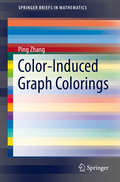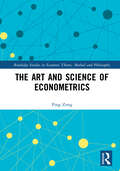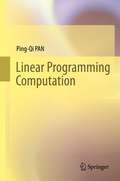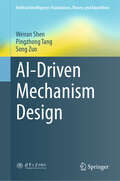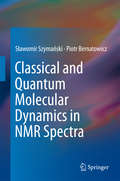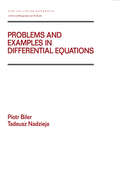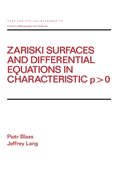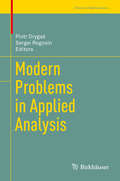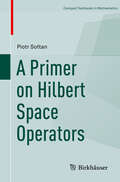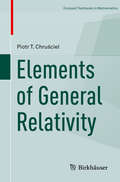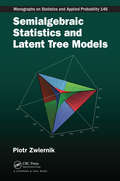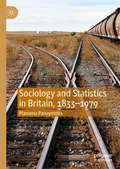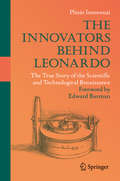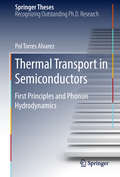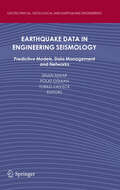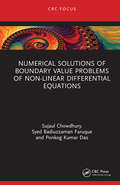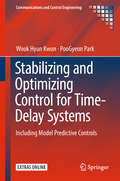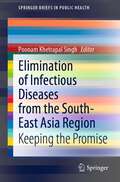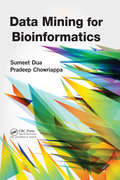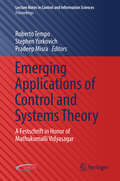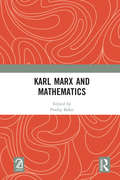- Table View
- List View
Color-Induced Graph Colorings: Vertex And Neighbor Distinguishing Edge Colorings Of Graphs (SpringerBriefs in Mathematics)
by Ping ZhangA comprehensive treatment of color-induced graph colorings is presented in this book, emphasizing vertex colorings induced by edge colorings. The coloring concepts described in this book depend not only on the property required of the initial edge coloring and the kind of objects serving as colors, but also on the property demanded of the vertex coloring produced. For each edge coloring introduced, background for the concept is provided, followed by a presentation of results and open questions dealing with this topic. While the edge colorings discussed can be either proper or unrestricted, the resulting vertex colorings are either proper colorings or rainbow colorings. This gives rise to a discussion of irregular colorings, strong colorings, modular colorings, edge-graceful colorings, twin edge colorings and binomial colorings. Since many of the concepts described in this book are relatively recent, the audience for this book is primarily mathematicians interested in learning some new areas of graph colorings as well as researchers and graduate students in the mathematics community, especially the graph theory community.
The Art and Science of Econometrics (Routledge Studies in Economic Theory, Method and Philosophy)
by Ping ZongToday econometrics has been widely applied in the empirical study of economics. As an empirical science, econometrics uses rigorous mathematical and statistical methods for economic problems. Understanding the methodologies of both econometrics and statistics is a crucial departure for econometrics. The primary focus of this book is to provide an understanding of statistical properties behind econometric methods. Following the introduction in Chapter 1, Chapter 2 provides the methodological review of both econometrics and statistics in different periods since the 1930s. Chapters 3 and 4 explain the underlying theoretical methodologies for estimated equations in the simple regression and multiple regression models and discuss the debates about p-values in particular. This part of the book offers the reader a richer understanding of the methods of statistics behind the methodology of econometrics. Chapters 5–9 of the book are focused on the discussion of regression models using time series data, traditional causal econometric models, and the latest statistical techniques. By concentrating on dynamic structural linear models like state-space models and the Bayesian approach, the book alludes to the fact that this methodological study is not only a science but also an art. This work serves as a handy reference book for anyone interested in econometrics, particularly in relevance to students and academic and business researchers in all quantitative analysis fields.
Linear Programming Computation
by Ping-Qi PanWith emphasis on computation, this book is a real breakthrough in the field of LP. In addition to conventional topics, such as the simplex method, duality, and interior-point methods, all deduced in a fresh and clear manner, it introduces the state of the art by highlighting brand-new and advanced results, including efficient pivot rules, Phase-I approaches, reduced simplex methods, deficient-basis methods, face methods, and pivotal interior-point methods. In particular, it covers the determination of the optimal solution set, feasible-point simplex method, decomposition principle for solving large-scale problems, controlled-branch method based on generalized reduced simplex framework for solving integer LP problems.
AI-Driven Mechanism Design (Artificial Intelligence: Foundations, Theory, and Algorithms)
by Weiran Shen Pingzhong Tang Song ZuoDue to its huge success in industry, mechanism design has been one of the central research topics at the interface of economics and computer science. However, despite decades of effort, there are still numerous challenges, in terms of both theory and applications. These include the problem of how to design mechanisms for selling multiple items, dynamic auctions, and balancing multiple objectives, given the huge design space and buyer strategy space; and the fact that in practice, the most widely applied auction format (the generalized second price auction) is neither truthful nor optimal. Furthermore, many theoretical results are based upon unrealistic assumptions that do not hold in real applications. This book presents the AI-driven mechanism design framework, which aims to provide an alternative way of dealing with these problems. The framework features two abstract models that interact with each other: the agent model and the mechanism model. By combining AI techniques with mechanism design theory, it solves problems that cannot be solved using tools from either domain alone. For example, it can reduce the mechanism space significantly, build more realistic buyer models, and better balance different objectives. The book focuses on several aspects of mechanism design and demonstrates that the framework is useful in both theoretical analysis and practical applications.
Classical and Quantum Molecular Dynamics in NMR Spectra
by Sławomir Szymański Piotr BernatowiczThe book provides a detailed account of how condensed-phase molecular dynamics are reflected in the line shapes of NMR spectra. The theories establishing connections between random, time-dependent molecular processes and lineshape effects are exposed in depth. Special emphasis is placed on the theoretical aspects, involving in particular intermolecular processes in solution, and molecular symmetry issues. The Liouville super-operator formalism is briefly introduced and used wherever it is beneficial for the transparency of presentation. The proposed formal descriptions of the discussed problems are sufficiently detailed to be implemented on a computer. Practical applications of the theory in solid- and liquid-phase studies are illustrated with appropriate experimental examples, exposing the potential of the lineshape method in elucidating molecular dynamics NMR-observable molecular phenomena where quantization of the spatial nuclear degrees of freedom is crucial are addressed in the last part of the book. As an introduction to this exciting research field, selected aspects of the quantum mechanics of isolated systems undergoing rotational tunnelling are reviewed, together with some basic information about quantum systems interacting with their condensed environment. The quantum theory of rate processes evidenced in the NMR lineshapes of molecular rotors is presented, and illustrated with appropriate experimental examples from both solid- and liquid-phase spectra. In this context, the everlasting problem of the quantum-to-classical transition is discussed at a quantitative level. The book will be suitable for graduate students and new and practising researchers using NMR techniques.
Problems and Examples in Differential Equations
by Piotr Biler Tadeusz NadziejaThis book presents original problems from graduate courses in pure and applied mathematics and even small research topics, significant theorems and information on recent results. It is helpful for specialists working in differential equations.
Zariski Surfaces and Differential Equations in Characteristic P < O (Chapman And Hall/crc Pure And Applied Mathematics Ser. #106)
by Piotr BlassThis book represents the current (1985) state of knowledge about Zariski surfaces and related topics in differential equations in characteristic p > 0. It is aimed at research mathematicians and graduate and advanced undergraduate students of mathematics and computer science.
Modern Problems in Applied Analysis (Trends in Mathematics)
by Piotr Drygaś Sergei RogosinThis book features a collection of recent findings in Applied Real and Complex Analysis that were presented at the 3rd International Conference “Boundary Value Problems, Functional Equations and Applications” (BAF-3), held in Rzeszow, Poland on 20-23 April 2016. The contributions presented here develop a technique related to the scope of the workshop and touching on the fields of differential and functional equations, complex and real analysis, with a special emphasis on topics related to boundary value problems. Further, the papers discuss various applications of the technique, mainly in solid mechanics (crack propagation, conductivity of composite materials), biomechanics (viscoelastic behavior of the periodontal ligament, modeling of swarms) and fluid dynamics (Stokes and Brinkman type flows, Hele-Shaw type flows). The book is addressed to all readers who are interested in the development and application of innovative research results that can help solve theoretical and real-world problems.
A Primer on Hilbert Space Operators (Compact Textbooks in Mathematics)
by Piotr SołtanThe book concisely presents the fundamental aspects of the theory of operators on Hilbert spaces. The topics covered include functional calculus and spectral theorems, compact operators, trace class and Hilbert-Schmidt operators, self-adjoint extensions of symmetric operators, and one-parameter groups of operators. The exposition of the material on unbounded operators is based on a novel tool, called the z-transform, which provides a way to encode full information about unbounded operators in bounded ones, hence making many technical aspects of the theory less involved.
Elements of General Relativity (Compact Textbooks in Mathematics)
by Piotr T. ChruścielThis book provides an introduction to the mathematics and physics of general relativity, its basic physical concepts, its observational implications, and the new insights obtained into the nature of space-time and the structure of the universe. It introduces some of the most striking aspects of Einstein's theory of gravitation: black holes, gravitational waves, stellar models, and cosmology. It contains a self-contained introduction to tensor calculus and Riemannian geometry, using in parallel the language of modern differential geometry and the coordinate notation, more familiar to physicists. The author has strived to achieve mathematical rigour, with all notions given careful mathematical meaning, while trying to maintain the formalism to the minimum fit-for-purpose. Familiarity with special relativity is assumed. The overall aim is to convey some of the main physical and geometrical properties of Einstein's theory of gravitation, providing a solid entry point to further studies of the mathematics and physics of Einstein equations.
Semialgebraic Statistics and Latent Tree Models
by Piotr ZwiernikThe first part of the book gives a general introduction to key concepts in algebraic statistics, focusing on methods that are helpful in the study of models with hidden variables. The author uses tensor geometry as a natural language to deal with multivariate probability distributions, develops new combinatorial tools to study models with hidden data, and describes the semialgebraic structure of statistical models.The second part illustrates important examples of tree models with hidden variables. The book discusses the underlying models and related combinatorial concepts of phylogenetic trees as well as the local and global geometry of latent tree models. It also extends previous results to Gaussian latent tree models.This book shows you how both combinatorics and algebraic geometry enable a better understanding of latent tree models. It contains many results on the geometry of the models, including a detailed analysis of identifiability and the defining polynomial constraints
Sociology and Statistics in Britain, 1833–1979
by Plamena PanayotovaAt the beginning of the twentieth century, Britain stood at the forefront of science and statistics and had a long and respected tradition of social investigation and reform. But it still did not yet have a ‘science of society.’ When, in the early 1900s, a small band of enthusiasts got together to address this situation, the scene was set for a grand synthesis. No such synthesis ever took place and, instead, British sociology has followed a resolutely non-statistical path. Sociology and Statistics in Britain, 1833-1979 investigates how this curious situation came about and attempts to explain it from an historical perspective. It uncovers the prevalence of a deep and instinctive distrust within British sociology of the statistical methodology and mindset, resulting in a mix of quiet indifference and active hostility, which has persisted from its beginnings right up to the present day. While British sociology has thrived institutionally since the post-war expansion of higher education, this book asks whether or not it is poorer for having failed to recognise that statistics provides the foundations for the scientific study of society and for having missed opportunities to build upon those foundations. Ultimately, this important, revealing and timely book is about British sociology’s refusal to come to grips with a modern scientific way of thinking which no discipline that aspires to an effective study of society can afford to ignore.
The Innovators Behind Leonardo: The True Story of the Scientific and Technological Renaissance
by Plinio InnocenziThis engaging book places Leonardo da Vinci’s scientific achievements within the wider context of the rapid development that occurred during the Renaissance. It demonstrates how his contributions were not in fact born of isolated genius, but rather part of a rich period of collective advancement in science and technology, which began at least 50 years prior to his birth.Readers will discover a very special moment in history, when creativity and imagination were changing the future—shaping our present. They will be amazed to discover how many technological inventions had already been conceived or even designed by the engineers and inventors who preceded Leonardo, such as Francesco di Giorgio and Taccola, the so-called Siena engineers. This engaging volume features a wealth of illustrations from a variety of original sources, such as manuscripts and codices, enabling the reader to see and judge for him or herself the influence that other Renaissance engineers and inventors had on Leonardo.
Lying Numbers: How Maths and Statistics Are Twisted and Abused
by Pocket Book of R Hugh BarkerA readily understandable exploration of how figures are badly reported or deliberately misrepresented everywhere from political arguments and briefings to business presentations and shopping offers.Praise for Hugh Barker's Million Dollar Maths:'Great fun. A clear, original and highly readable account of the curious relationship between mathematics and money.' Professor Ian Stewart - author of Significant Figures'A lively crash course in the mathematics of gambling, investing, and managing. Hugh Barker makes deep ideas fun and profitable.' William Poundstone - author of How to Predict the Unpredictable Politicians, economists, scientists, journalists . . . all of them have been known to bend the truth and to twist the facts from time to time. But surely the numbers and statistics they rely on are cold, hard objective facts that tell the real story? Of course the truth is much murkier than that. Figures can be misinterpreted, misunderstood, misconstrued and misused in hundreds of different ways. This book takes a look at the many ways that statistical information can be badly reported or deliberately misused in all walks of life, from political arguments, to business presentations, to more local concerns such as shopping offers and utility bills. A polemical guide to how numbers are used to mislead, which is intended to help the reader through the minefield of dubious stats and lying numbers.
Statistical Methodologies with Medical Applications
by Poduri Srs RaoThis book presents the methodology and applications of a range of important topics in statistics, and is designed for graduate students in Statistics and Biostatistics and for medical researchers. Illustrations and more than ninety exercises with solutions are presented. They are constructed from the research findings of the medical journals, summary reports of the Centre for Disease Control (CDC) and the World Health Organization (WHO), and practical situations. The illustrations and exercises are related to topics such as immunization, obesity, hypertension, lipid levels, diet and exercise, harmful effects of smoking and air pollution, and the benefits of gluten free diet. This book can be recommended for a one or two semester graduate level course for students studying Statistics, Biostatistics, Epidemiology and Health Sciences. It will also be useful as a companion for medical researchers and research oriented physicians.
Thermal Transport in Semiconductors: First Principles and Phonon Hydrodynamics (Springer Theses)
by Pol Torres AlvarezStarting from a broad overview of heat transport based on the Boltzmann Transport Equation, this book presents a comprehensive analysis of heat transport in bulk and nanomaterials based on a kinetic-collective model (KCM). This has become key to understanding the field of thermal transport in semiconductors, and represents an important stride. The book describes how heat transport becomes hydrodynamic at the nanoscale, propagating very much like a viscous fluid and manifesting vorticity and friction-like behavior. It introduces a generalization of Fourier’s law including a hydrodynamic term based on collective behavior in the phonon ensemble. This approach makes it possible to describe in a unifying way recent experiments that had to resort to unphysical assumptions in order to uphold the validity of Fourier’s law, demonstrating that hydrodynamic heat transport is a pervasive type of behavior in semiconductors at reduced scales.
Earthquake Data in Engineering Seismology
by Polat Gülkan Sinan Akkar Torild Van EckThis book addresses current activities in strong-motion networks around the globe, covering issues related to designing, maintaining and disseminating information from these arrays. The book is divided into three principal sections. The first section includes recent developments in regional and global ground-motion predictive models. It presents discussions on the similarities and differences of ground motion estimations from these models and their application to design spectra as well as other novel procedures for predicting engineering parameters in seismic regions with sparse data. The second section introduces topics about the particular methodologies being implemented in the recently established global and regional strong-motion databanks in Europe to maintain and disseminate the archived accelerometric data. The final section describes major strong-motion arrays around the world and their historical developments. The last three chapters of this section introduce projects carried out within the context of arrays deployed for seismic risk studies in metropolitan areas. Audience: This timely book will be of particular interest for researchers who use accelerometric data extensively to conduct studies in earthquake engineering and engineering seismology.
Numerical Solutions of Boundary Value Problems of Non-linear Differential Equations
by Sujaul Chowdhury Syed Badiuzzaman Faruque Ponkog Kumar DasThe book presents in comprehensive detail numerical solutions to boundary value problems of a number of non-linear differential equations. Replacing derivatives by finite difference approximations in these differential equations leads to a system of non-linear algebraic equations which we have solved using Newton’s iterative method. In each case, we have also obtained Euler solutions and ascertained that the iterations converge to Euler solutions. We find that, except for the boundary values, initial values of the 1st iteration need not be anything close to the final convergent values of the numerical solution. Programs in Mathematica 6.0 were written to obtain the numerical solutions.
Stabilizing and Optimizing Control for Time-Delay Systems: Including Model Predictive Controls (Communications and Control Engineering)
by Wook Hyun Kwon PooGyeon ParkStabilizing and Optimizing Control for Time-Delay Systems introduces three important classes of stabilizing controls for time-delay systems: non-optimal (without performance criteria); suboptimal (including guaranteed costs); and optimal controls. Each class is treated in detail and compared in terms of prior control structures. State- and input-delayed systems are considered. The book provides a unified mathematical framework with common notation being used throughout. Receding-horizon, or model predictive, linear quadratic (LQ), linear-quadratic-Gaussian and H∞ controls for time-delay systems are chosen as optimal stabilizing controls. Cost monotonicity is investigated in order to guarantee the asymptotic stability of closed-loop systems operating with such controls. The authors use guaranteed LQ and H∞ controls as representative sub-optimal methods; these are obtained with pre-determined control structures and certain upper bounds of performance criteria. Non-optimal stabilizing controls are obtained with predetermined control structures but with no performance criteria. Recently developed inequalities are exploited to obtain less conservative results. To facilitate computation, the authors use linear matrix inequalities to represent gain matrices for non-optimal and sub-optimal stabilizing controls, and all the initial conditions of coupled differential Riccati equations of optimal stabilizing controls. Numerical examples are provided with MATLAB® codes (downloadable from http://extras.springer.com/) to give readers guidance in working with more difficult optimal and suboptimal controls. Academic researchers studying control of a variety of real processes in chemistry, biology, transportation, digital communication networks and mechanical systems that are subject to time delays will find the results presented in Stabilizing and Optimizing Control for Time-Delay Systems to be helpful in their work. Practitioners working in related sectors of industry will also find this book to be of use in developing real-world control systems for the many time-delayed processes they encounter.
Elimination of Infectious Diseases from the South-East Asia Region: Keeping the Promise (SpringerBriefs in Public Health)
by Poonam Khetrapal SinghThis book discusses the historical context, country experience, and best practices that led to eliminating infectious diseases from the WHO’s South-East Asia Region, such as malaria, lymphatic filariasis, yaws, trachoma, and mother-to-child HIV in the mid-twentieth and twenty-first century. The UN Sustainable Development Goals (3.3) targets to end AIDS, tuberculosis, malaria, and neglected tropical diseases and combat hepatitis, water-borne diseases and other communicable diseases by 2030. In this context, this book is of high significance to countries from the SEA region and around the globe. It helps create national strategies and action plans on infectious disease elimination and thus attaining SDG 3.3.
Randomized Algorithms
by Prabhakar Raghavan Rajeev MotwaniFor many applications, a randomized algorithm is either the simplest or the fastest algorithm available, and sometimes both. This book introduces the basic concepts in the design and analysis of randomized algorithms. The first part of the text presents basic tools such as probability theory and probabilistic analysis that are frequently used in algorithmic applications. Algorithmic examples are also given to illustrate the use of each tool in a concrete setting. In the second part of the book, each chapter focuses on an important area to which randomized algorithms can be applied, providing a comprehensive and representative selection of the algorithms that might be used in each of these areas. Although written primarily as a text for advanced undergraduates and graduate students, this book should also prove invaluable as a reference for professionals and researchers.
Data Mining for Bioinformatics
by Sumeet Dua Pradeep ChowriappaCovering theory, algorithms, and methodologies, as well as data mining technologies, Data Mining for Bioinformatics provides a comprehensive discussion of data-intensive computations used in data mining with applications in bioinformatics. It supplies a broad, yet in-depth, overview of the application domains of data mining for bioinformatics to he
Emerging Applications of Control and Systems Theory: A Festschrift In Honor Of Mathukumalli Vidyasagar (Lecture Notes In Control And Information Sciences - Proceedings Ser.)
by Roberto Tempo Stephen Yurkovich Pradeep MisraThis book celebrates Professor Mathukumalli Vidyasagar’s outstanding achievements in systems, control, robotics, statistical learning, computational biology, and allied areas. The contributions in the book summarize the content of invited lectures given at the workshop “Emerging Applications of Control and Systems Theory” (EACST17) held at the University of Texas at Dallas in late September 2017 in honor of Professor Vidyasagar’s seventieth birthday. These contributions are the work of twenty-eight distinguished speakers from eight countries and are related to Professor Vidyasagar’s areas of research. This Festschrift volume will remain as a permanent scientific record of this event.
Karl Marx and Mathematics
by Pradip BaksiThis collection of various texts on Karl Marx and Mathematics is the revised and extended second edition of the Special Supplement to Karl Marx, Mathematical Manuscripts (1994; Calcutta: Viswakos) titled Marx and Mathematics. The sources of the texts included in the three parts of this collection and, some biographical information about their respective authors have been indicated at the end of each text. The emergence and development of the Ethnomathematics movement continue to change our understanding of the history of evolution of plural mathematics on planet earth since the Neolithic age. Rediscovery and study of some of the neglected source texts have further energized investigations on the subsequent history of mathematical cultures, including those on the histories of algebra and analysis in some of the ancient and medieval languages of Asia, like Sanskrit, Arabic and Malayalam. Consequently, it is now possible to indicate some of the larger gaps in the dominant understanding of history of mathematics not only in Marx’s time, but also at the time of editing Marx’s mathematical manuscripts in the twentieth century, and even today. Finally, the emergence and development of mathematical and statistical software packages are vigorously reshaping our ways of conceptualizing and doing mathematics towards an unknown future. It is time now for taking yet another look at all mathematical text from the past and that includes the mathematical manuscripts of Marx. These texts have been divided into three parts. Part one contains some topical texts related to the history of emergence, development, editing, publication and reception of the mathematical manuscripts of Karl Marx. Part two contains a selection of five articles reflecting some of the investigations inspired by these manuscripts in Russia, India and France. Part three contains five articles on plural mathematics before and after Karl Marx (1818-1883). The texts in this collection are followed by two appendices containing two bibliographies: one on Hegel and mathematics and, the other on mathematics and semiotics. Please note: This title is co-published with Aakar Books, Bew Delhi. Taylor & Francis does not sell or distribute the print edition in South Asia (India, Sri Lanka, Nepal, Bangladesh, Pakistan, Maldives or Bhutan).
Soft Computing Techniques in Engineering, Health, Mathematical and Social Sciences (Edge AI in Future Computing)
by S. A. Mohiuddine Pradip DebnathSoft computing techniques are no longer limited to the arena of computer science. The discipline has an exponentially growing demand in other branches of science and engineering and even into health and social science. This book contains theory and applications of soft computing in engineering, health, and social and applied sciences. Different soft computing techniques such as artificial neural networks, fuzzy systems, evolutionary algorithms and hybrid systems are discussed. It also contains important chapters in machine learning and clustering. This book presents a survey of the existing knowledge and also the current state of art development through original new contributions from the researchers. This book may be used as a one-stop reference book for a broad range of readers worldwide interested in soft computing. In each chapter, the preliminaries have been presented first and then the advanced discussion takes place. Learners and researchers from a wide variety of backgrounds will find several useful tools and techniques to develop their soft computing skills. This book is meant for graduate students, faculty and researchers willing to expand their knowledge in any branch of soft computing. The readers of this book will require minimum prerequisites of undergraduate studies in computation and mathematics.
